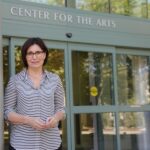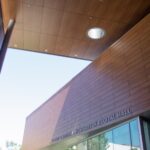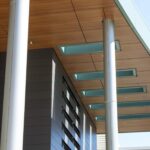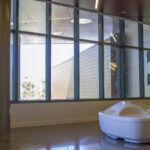PCC’s Center for the Arts unique design elements qualified it for “exemplifying a level of excellence in architectural design” for an Institutional Building for design firm AC Martin, winning the firm the Design Excellence 2014 Citation Award from San Fernando Valley Chapter of the American Institute of Architects (AIA) earlier this year.
Gail Bouvrie, director of design at AC Martin and the lead designer on the Center for the Arts project, has worked on various projects that have previously received the prestigious award.
She explained that through anonymous submission for consideration, AC Martin won for its service.
The Center for the Arts building had its ribbon cutting in January 2014. But for a building that was a long time in the planning and execution stages for nearly a decade, this was momentous.
And this year’s AIA recognition is a testament.
“It was a miracle that we opened that building in the fall of 2013, but we opened in phases,” said Rueben Smith, PCC’s executive director of facilities. “There’s three separate buildings…so final completion was January of 2014. The recital hall was last.”
Stephanie Pulcifer, space manager at PCC and a project manager on the bond measure team, helped to take the Center for the Arts building through the design development stages, where award-winning architectural firm AC Martin’s bid was ultimately chosen.
“The building was part of the master plan and was the last building we built,” Pulcifer said. They had experience in arts and performing arts, and that was key. They had a vision that spoke to the committee that chose them,” said Pulcifer. “[They effectively] married two creative functions into one space where they lived together harmoniously.”
Bouvrie spoke extensively on the awarding process, on how she came to the project and her initial ideas for the building that was based on the committee’s criteria.
During a process called “programming,” Bouvrie and team members from AC Martin reviewed the initial space to discuss PCC’s initial requirements.
The AC Martin team met extensively with various faculty members and the department deans to determine priorities and to accommodate the space and acoustics and equipment needs for the art and music departments.
“Typically the knee-jerk reaction would be to separate the music—which is noisy—from the art, which can be messy,” she said. “But we really wanted to energize the building, so we mixed up those spaces so that when you walk down the hall, you’ll be able to have the rehearsal hall next to a 3D design studio next to the jewelry lab.”
This was particularly true for the first floor of the building, where they decided to “mix up the music and the art quite a bit,” according to Bouvrie.
And this was a particular challenge concerning the jewelry classroom space because of the “tremendous exhaust requirements.”
“But we made the decision because it was such an interesting space to put on display in the middle of the building and provide a lot of glass looking into the space, and that’s actually been quite successful,” she said. “The idea was to create a sort of main street that the rooms were off of the main street, connecting the east and west of the campus, became almost like shop windows where people would walk by and they’d see interesting stuff going on,” she continued.
The new building also created attractive transitory walkways between buildings.
Joseph Futtner, associate dean of the Visual Arts and Media Studies, discussed the elements that made it into the final product that now contains his office and elaborated on the joys that come with it.
According to Futtner the space was “a kind of a no man’s land” prior to the existence of the Center of for the Arts building, and had looked forward to the increased circulation on that side of the campus.
“They were hidden, basically, from the rest of the campus,” said Bouvrie. “So one of our major goals of the project was to sort of reveal to the rest of the campus, and the Pasadena community in general.”
The main street aspect of the first floor corridor was a notable key element added to encourage the slowing of traffic and bring attention to the peek-through “store front window” aspect of the classrooms and the jewelry, video, art and music display cases.
“This is a place that is kind of designed to delay, and retard, and engage in a same sense that music or dance has those meters and moments and dynamics,” said Futtner. “It’s an extraordinarily rich and unarguably rewarding opportunity to walk down that [main street] corridor of the building.”
Dance and drawing classes have begun to incorporate an exercise that involves both disciplines.
“This is truly an example of that type of serendipitous exchange of ideas across discipline silos,” Futtner said.
Bouvrie said they tried as much as possible to create large spaces within the corridors to encourage a student hang outs between classes. This was a special focus for spaces on the second floor.
“Those sort of spaces were created for students to hang out and to engage with each other,” she said. “We wanted have both sides bring music and art together, but at the same time maintain their separate identities.”
To maintain those identities, the design incorporated unique entrances for access to the art gallery and the recital hall in order to showcase them, to aesthetically reflect them, and to provide plazas and an outdoor lobby space for before and after events and to engage the campus.
“Formally, the recital hall was inspired by two things. One was the fact that it was facing the sculpture garden. So that allowed us to actually start to think about a sculptural form that was different than anything at PCC at the time,” she said. “And we then decided to look at the sides of musical instruments—the cello, the violin—so the sort of wooden curve that faces out to the sculpture garden was informed by the shape of musical instruments.”
They also looked at some historical aspects of the existing buildings on campus.
The frieze included at the top of the building recalls that of some of the historical buildings around campus, as well as the style of the long windows that are facing south.
And with all that was incorporated into the building, with budget and space restrictions, there were a few additional flourishes and accommodations Bouvrie wishes they could have incorporated still.
“We weren’t able to include the sculpture and ceramic studios, and the printmaking. So if I was going to change anything, I would say that I wish we could have incorporated those spaces. There were some issues with only being able to accommodate a certain amount of square footage, so some things had to be cut.”
“I think that the building could have used more student collaboration spaces,” she said. “And I think that there could have been some sort of food service in the building, because that’s a tremendous draw for the students.”
Overall Bouvrie was quite pleased with the outcome, the process and the experience.
“The project just had a wonderful set of criteria and it is sort of a dream for an architect to do a project like this,” she said. “I was so impressed with [the deans and faculty] at PCC, their dedication—and for so many years. They were working in substandard spaces and they were doing just amazing things. So it was really quite a wonderful experience.”
- Legacy of Courier adviser lives on - April 27, 2016
- Campus Police win first place in run from Baker to Vegas - April 22, 2016
- Condom van rolls onto campus to combat HIV - April 27, 2016





The great-looking building has only one [very slow] elevator.
Not so helpful for the disabled…